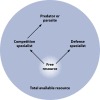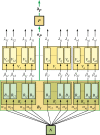Trade-offs between competition and defense specialists among unicellular planktonic organisms: the "killing the winner" hypothesis revisited
- PMID: 20197498
- PMCID: PMC2832346
- DOI: 10.1128/MMBR.00034-09
Trade-offs between competition and defense specialists among unicellular planktonic organisms: the "killing the winner" hypothesis revisited
Abstract
A trade-off between strategies maximizing growth and minimizing losses appears to be a fundamental property of evolving biological entities existing in environments with limited resources. In the special case of unicellular planktonic organisms, the theoretical framework describing the trade-offs between competition and defense specialists is known as the "killing the winner" hypothesis (KtW). KtW describes how the availability of resources and the actions of predators (e.g., heterotrophic flagellates) and parasites (e.g., viruses) determine the composition and biogeochemical impact of such organisms. We extend KtW conceptually by introducing size- or shape-selective grazing of protozoans on prokaryotes into an idealized food web composed of prokaryotes, lytic viruses infecting prokaryotes, and protozoans. This results in a hierarchy analogous to a Russian doll, where KtW principles are at work on a lower level due to selective viral infection and on an upper level due to size- or shape-selective grazing by protozoans. Additionally, we critically discuss predictions and limitations of KtW in light of the recent literature, with particular focus on typically neglected aspects of KtW. Many aspects of KtW have been corroborated by in situ and experimental studies of isolates and natural communities. However, a thorough test of KtW is still hampered by current methodological limitations. In particular, the quantification of nutrient uptake rates of the competing prokaryotic populations and virus population-specific adsorption and decay rates appears to be the most daunting challenge for the years to come.
Figures




Similar articles
-
Optimal defense strategies in an idealized microbial food web under trade-off between competition and defense.PLoS One. 2014 Jul 7;9(7):e101415. doi: 10.1371/journal.pone.0101415. eCollection 2014. PLoS One. 2014. PMID: 24999739 Free PMC article.
-
Ecology of planktonic heterotrophic flagellates. A review.Riv Biol. 2003 Jan-Apr;96(1):55-71. Riv Biol. 2003. PMID: 12852174 Review.
-
Predation on prokaryotes in the water column and its ecological implications.Nat Rev Microbiol. 2005 Jul;3(7):537-46. doi: 10.1038/nrmicro1180. Nat Rev Microbiol. 2005. PMID: 15953930 Review.
-
Foraging trade-offs, flagellar arrangements, and flow architecture of planktonic protists.Proc Natl Acad Sci U S A. 2021 Jan 19;118(3):e2009930118. doi: 10.1073/pnas.2009930118. Proc Natl Acad Sci U S A. 2021. PMID: 33431666 Free PMC article.
-
Simple models combining competition, defence and resource availability have broad implications in pelagic microbial food webs.Ecol Lett. 2018 Sep;21(9):1440-1452. doi: 10.1111/ele.13122. Epub 2018 Jul 17. Ecol Lett. 2018. PMID: 30014593 Review.
Cited by
-
Genome of a SAR116 bacteriophage shows the prevalence of this phage type in the oceans.Proc Natl Acad Sci U S A. 2013 Jul 23;110(30):12343-8. doi: 10.1073/pnas.1219930110. Epub 2013 Jun 24. Proc Natl Acad Sci U S A. 2013. PMID: 23798439 Free PMC article.
-
Diverse Marine T4-like Cyanophage Communities Are Primarily Comprised of Low-Abundance Species Including Species with Distinct Seasonal, Persistent, Occasional, or Sporadic Dynamics.Viruses. 2023 Feb 20;15(2):581. doi: 10.3390/v15020581. Viruses. 2023. PMID: 36851794 Free PMC article.
-
Randomly amplified polymorphic DNA reveals tight links between viruses and microbes in the bathypelagic zone of the Northwestern Mediterranean Sea.Appl Environ Microbiol. 2010 Oct;76(20):6724-32. doi: 10.1128/AEM.00531-10. Epub 2010 Aug 20. Appl Environ Microbiol. 2010. PMID: 20729320 Free PMC article.
-
Rare Taxa Exhibit Disproportionate Cell-Level Metabolic Activity in Enriched Anaerobic Digestion Microbial Communities.mSystems. 2019 Jan 22;4(1):e00208-18. doi: 10.1128/mSystems.00208-18. eCollection 2019 Jan-Feb. mSystems. 2019. PMID: 30687779 Free PMC article.
-
Disentangling the relative influence of bacterioplankton phylogeny and metabolism on lysogeny in reservoirs and lagoons.ISME J. 2011 May;5(5):831-42. doi: 10.1038/ismej.2010.181. Epub 2010 Dec 2. ISME J. 2011. PMID: 21124489 Free PMC article.
References
-
- Andersson, A. F., and J. F. Banfield. 2008. Virus population dynamics and acquired virus resistance in natural microbial communities. Science 320:1047-1050. - PubMed
-
- Angly, F. E., B. Felts, M. Breitbart, P. Salamon, R. A. Edwards, C. Carlson, A. M. Chan, M. Haynes, S. Kelley, H. Liu, J. M. Mahaffy, J. E. Mueller, J. Nulton, R. Olson, R. Parsons, S. Rayhawk, C. A. Suttle, and F. Rohwer. 2006. The marine viromes of four oceanic regions. PLoS Biol. 4:e368. - PMC - PubMed
-
- Auguet, J. C., H. Montanié, H. J. Hartmann, P. Lebaron, E. O. Casamayor, P. Catala, and D. Delmas. 2008. Potential effect of freshwater virus on the structure and activity of bacterial communities in the Marennes-Oléron Bay (France). Microb. Ecol. 57:295-306. - PubMed
-
- Azam, F., and F. Malfatti. 2007. Microbial structuring of marine ecosystems. Nat. Rev. Microbiol. 5:782-791. - PubMed
-
- Barrangou, R., C. Fremaux, H. Deveau, M. Richards, P. Boyaval, S. Moineau, D. A. Romero, and P. Horvath. 2007. CRISPR provides acquired resistance against viruses in prokaryotes. Science 315:1709-1712. - PubMed
Publication types
MeSH terms
LinkOut - more resources
Full Text Sources

